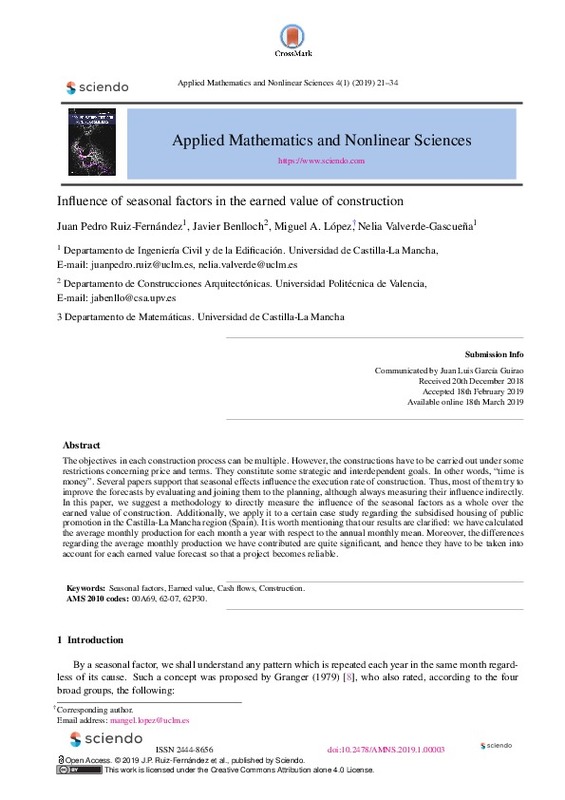JavaScript is disabled for your browser. Some features of this site may not work without it.
Buscar en RiuNet
Listar
Mi cuenta
Estadísticas
Ayuda RiuNet
Admin. UPV
Influence of seasonal factors in the earned value of construction
Mostrar el registro sencillo del ítem
Ficheros en el ítem
| dc.contributor.author | Ruiz-Fernández, Juan Pedro
|
es_ES |
| dc.contributor.author | Benlloch Marco, Javier
|
es_ES |
| dc.contributor.author | López, Miguel A.
|
es_ES |
| dc.contributor.author | Valverde-Gascueña, Nelia
|
es_ES |
| dc.date.accessioned | 2021-01-16T04:31:50Z | |
| dc.date.available | 2021-01-16T04:31:50Z | |
| dc.date.issued | 2019-03-18 | es_ES |
| dc.identifier.uri | http://hdl.handle.net/10251/159199 | |
| dc.description.abstract | [EN] The objectives in each construction process can be multiple. However, the constructions have to be carried out under some restrictions concerning price and terms. They constitute some strategic and interdependent goals. In other words, ¿time is money¿. Several papers support that seasonal effects influence the execution rate of construction. Thus, most of them try to improve the forecasts by evaluating and joining them to the planning, although always measuring their influence indirectly. In this paper, we suggest a methodology to directly measure the influence of the seasonal factors as a whole over the earned value of construction. Additionally, we apply it to a certain case study regarding the subsidised housing of public promotion in the Castilla-La Mancha region (Spain). It is worth mentioning that our results are clarified: we have calculated the average monthly production for each month a year with respect to the annual monthly mean. Moreover, the differences regarding the average monthly production we have contributed are quite significant, and hence they have to be taken into account for each earned value forecast so that a project becomes reliable. | es_ES |
| dc.description.sponsorship | The authors would like to thank Gicaman SA, Eres SA, and Urvial SA (construction companies) by the cession of their outcome data corresponding to 161 public promotions that gave rise to 5,319 subsidised housing. | es_ES |
| dc.language | Inglés | es_ES |
| dc.publisher | UP4 Institute of Sciences, S.L. | es_ES |
| dc.relation.ispartof | Applied Mathematics and Nonlinear Sciences | es_ES |
| dc.rights | Reconocimiento (by) | es_ES |
| dc.subject | Seasonal factors | es_ES |
| dc.subject | Earned value | es_ES |
| dc.subject | Cash flows | es_ES |
| dc.subject | Construction | es_ES |
| dc.subject.classification | CONSTRUCCIONES ARQUITECTONICAS | es_ES |
| dc.title | Influence of seasonal factors in the earned value of construction | es_ES |
| dc.type | Artículo | es_ES |
| dc.identifier.doi | 10.2478/AMNS.2019.1.00003 | es_ES |
| dc.rights.accessRights | Abierto | es_ES |
| dc.contributor.affiliation | Universitat Politècnica de València. Departamento de Construcciones Arquitectónicas - Departament de Construccions Arquitectòniques | es_ES |
| dc.description.bibliographicCitation | Ruiz-Fernández, JP.; Benlloch Marco, J.; López, MA.; Valverde-Gascueña, N. (2019). Influence of seasonal factors in the earned value of construction. Applied Mathematics and Nonlinear Sciences. 4(1):21-34. https://doi.org/10.2478/AMNS.2019.1.00003 | es_ES |
| dc.description.accrualMethod | S | es_ES |
| dc.relation.publisherversion | https://doi.org/10.2478/AMNS.2019.1.00003 | es_ES |
| dc.description.upvformatpinicio | 21 | es_ES |
| dc.description.upvformatpfin | 34 | es_ES |
| dc.type.version | info:eu-repo/semantics/publishedVersion | es_ES |
| dc.description.volume | 4 | es_ES |
| dc.description.issue | 1 | es_ES |
| dc.identifier.eissn | 2444-8656 | es_ES |
| dc.relation.pasarela | S\424740 | es_ES |
| dc.description.references | Koehn, E., & Brown, G. (1985). Climatic Effects on Construction. Journal of Construction Engineering and Management, 111(2), 129-137. doi:10.1061/(asce)0733-9364(1985)111:2(129) | es_ES |
| dc.description.references | El-Rayes, K., & Moselhi, O. (2001). Impact of Rainfall on the Productivity of Highway Construction. Journal of Construction Engineering and Management, 127(2), 125-131. doi:10.1061/(asce)0733-9364(2001)127:2(125) | es_ES |
| dc.description.references | Kenley, R., & Wilson, O. D. (1989). A construction project net cash flow model. Construction Management and Economics, 7(1), 3-18. doi:10.1080/01446198900000002 | es_ES |
| dc.description.references | Skitmore, M. (1992). Parameter prediction for cash flow forecasting models. Construction Management and Economics, 10(5), 397-413. doi:10.1080/01446199200000038 | es_ES |
| dc.description.references | Chan, D. W. M., & Kumaraswamy, M. M. (1995). A study of the factors affecting construction durations in Hong Kong. Construction Management and Economics, 13(4), 319-333. doi:10.1080/01446199500000037 | es_ES |
| dc.description.references | Kaka, A. P., & Price, A. D. F. (1993). Modelling standard cost commitment curves for contractors’ cash flow forecasting. Construction Management and Economics, 11(4), 271-283. doi:10.1080/01446199300000027 | es_ES |
| dc.description.references | Blyth, K., & Kaka, A. (2006). A novel multiple linear regression model for forecasting S‐curves. Engineering, Construction and Architectural Management, 13(1), 82-95. doi:10.1108/09699980610646511 | es_ES |
| dc.description.references | Khosrowshahi, F., & Kaka, A. P. (2007). A Decision Support Model for Construction Cash Flow Management. Computer-Aided Civil and Infrastructure Engineering, 22(7), 527-539. doi:10.1111/j.1467-8667.2007.00508.x | es_ES |








